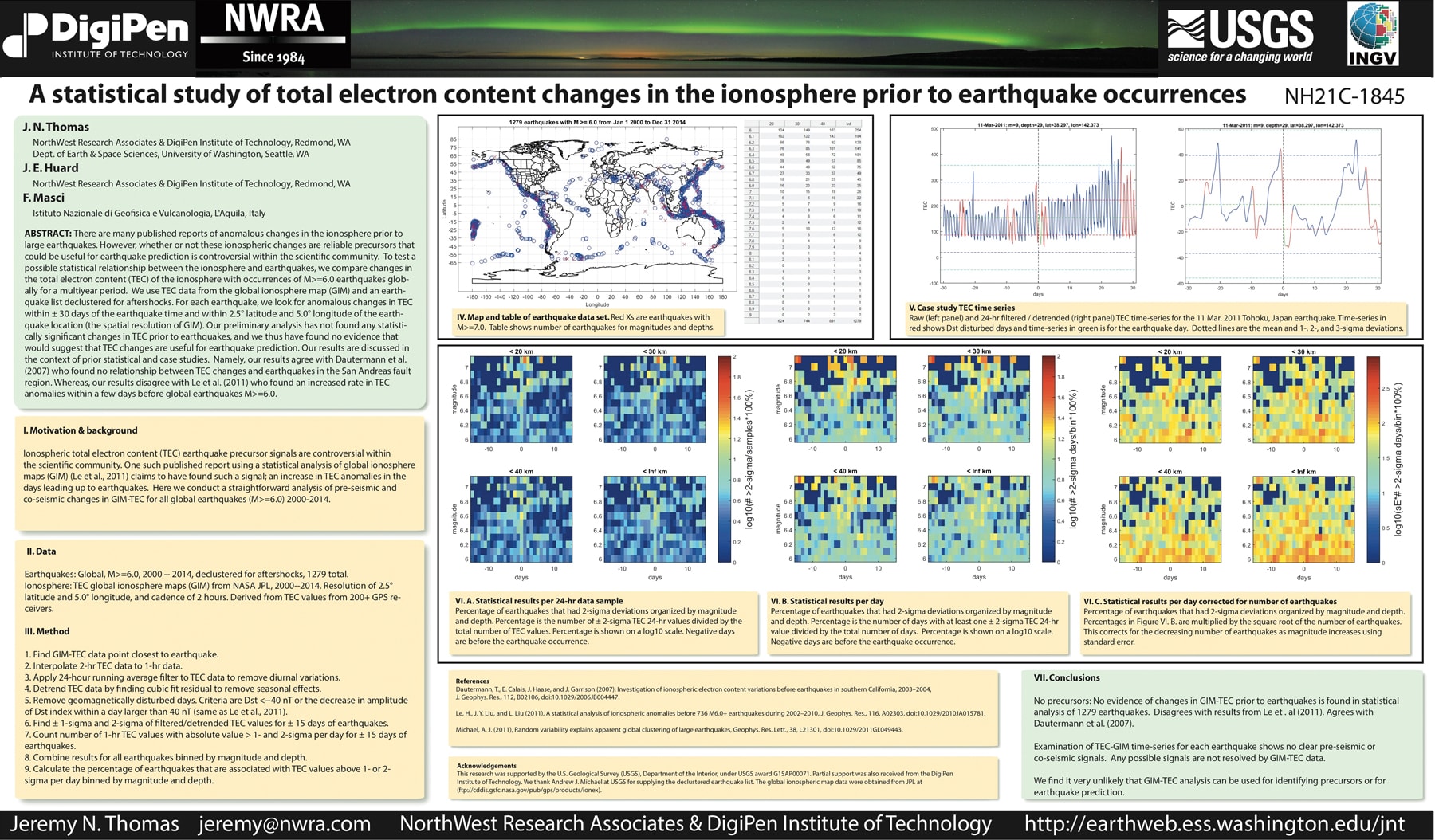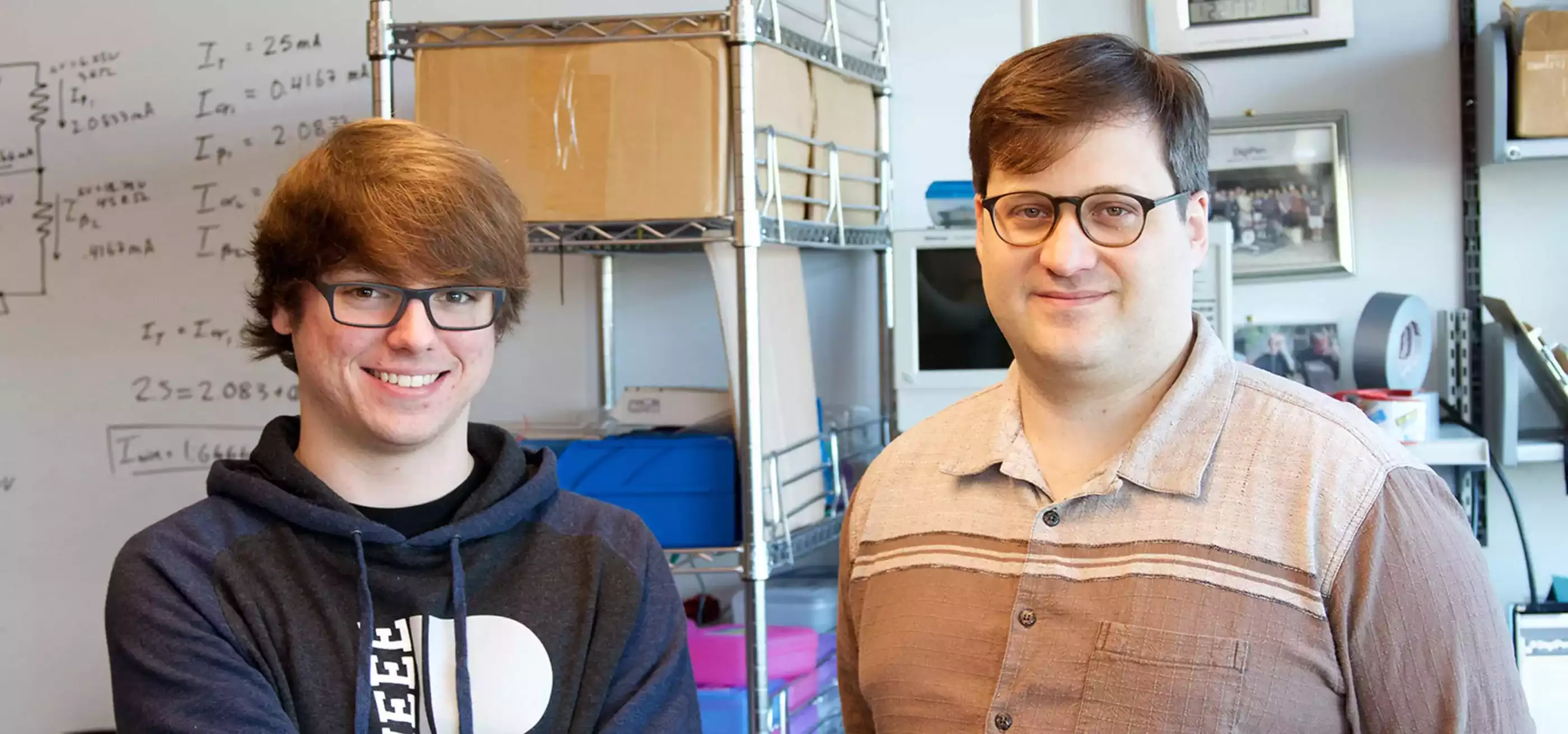Since 2015, Jimi Huard and Professor Jeremy Thomas have been working together on a project to determine if scientists can use atmospheric data to predict the occurrence of earthquakes — a claim made by other scientific reports in the past few years. The student and professor are combing through extensive piles of data to get a better sense of how changes in the ionosphere may be used to predict earthquakes.
“Most of the previous studies didn’t use this much data,” says Dr. Thomas, who is chair of DigiPen’s Electrical and Computer Engineering Department and an associate professor. Dr. Thomas first started working on earthquake-related studies for the U.S. Geological Survey in 2006 during his post-doctoral fellowship. “Originally, I started looking at electromagnetic signals that might precede earthquakes. And what I’m doing with Jimi now is looking at ionospheric signals — so the experiment is along the same lines [as my previous work], but with a different data set.”
Last spring, Dr. Thomas approached Jimi, who had taken the professor’s Digital Signal Processing course (ECE 420), and asked him if he would be interested in working on a project together in association with a local scientific research organization.
“Jeremy approached me with an internship offer to work [on this project] for NorthWest Research Associates,” Jimi says. “It was a great opportunity for me, so I jumped on board.”
Jimi, who is studying to earn a degree in the Bachelor of Science in Computer Engineering program at DigiPen, started working on the project last summer after the end of spring semester. He spent most of the summer sifting through a large set of data to identify any correlation between anomalous events in the ionosphere and the occurrence of earthquakes on the earth below. Even though he’s a full-time student at DigiPen during the fall and spring, Jimi continues to work on the research about one day per week with Dr. Thomas.
So far, their research has led the duo to doubt the accuracy of previous studies, which claimed that ionospheric anomalies predictably precede earthquakes. According to their own study, Jimi says, it is highly unlikely that scientists would be able to use ionospheric anomalies to predict earthquakes.
“There is potentially a significant co-seismic signal, meaning [the anomaly] happens at the same time as the earthquake, but there haven’t been any statistically significant pre-seismic signals,” says Jimi.

To arrive to their current conclusion, Jimi looks at earthquake events in their data set and finds the GPS signals nearest to the earthquake’s epicenter. “And then, taking that signal, we do some statistics to figure out, within a two-month range, how often anomalous events [in the ionosphere] happen. We can compare that to each earthquake, and use statistics to determine if a significant number of anomalous events correspond to the earthquakes.”
Though they’re fairly certain of their conclusion, Jimi and Dr. Thomas still have work to do before they can consider their study done, and the experiment is ongoing.
So far, Dr. Thomas and Jimi have created several iterations of a large, graph- and data-clad poster to illustrate their findings. They’ve presented it to the scientific community several times already; Jimi showed a digital version of the poster at a virtual convention for undergraduate students by the American Geophysical Union (AGU). In December last year, Professor Thomas presented a physical version of the poster at the AGU Fall Meeting in San Francisco.
“The USGS’s stance is that earthquakes are not really predictable,” Dr. Thomas says. His and Jimi’s findings seem to confirm that position, at least so far as ionospheric data goes. Dr. Thomas is quick to clarify that their findings shouldn’t be taken to indicate that scientists cannot predict earthquakes — only that ionospheric data is “probably not” a viable way to do so.
It’s an opportunity to do real science that has big ramifications not just for the U.S., but for everyone.”
Jimi plans to graduate from DigiPen this April and pursue graduate studies in aerospace or electrical engineering with a focus on remote sensing. In addition to his joint research effort with Dr. Thomas, Jimi has already delved into the field of remote sensing with previous projects, including a high-altitude balloon he launched last summer. He’s excited that he’s been able to work on such an important scientific endeavor while studying at DigiPen. “It’s an opportunity to do real science that has big ramifications not just for the U.S., but for everyone,” he says. “Earthquakes are huge, devastating events, and the ability to predict them — or falsely predict them in some cases, maybe — would be huge. It has real-life consequences that you don’t normally get as an undergraduate student.”
Meanwhile, Dr. Thomas says he’ll be taking the study through its final stages. “It’s a long process,” he says, “That’s why I’ll have to lead that — Jimi will probably be off at graduate school or doing something else by the time it’s done.” In addition to the other final steps necessary to complete the study, Dr. Thomas will formalize his and Jimi’s conclusions in a research paper, which Dr. Thomas hopes to get published in The Journal of Geophysical Research (JGR), a high-impact academic journal that has already published several other studies by the professor. Jimi will be listed as a co-author on the paper, meaning that when it comes time to write his first paper in graduate school, he’ll already have some experience and a credit under his belt.
More of Dr. Jeremy Thomas’s research work can be found on his website, http://earthweb.ess.washington.edu/jnt/.
